Study of the Influence of the Type of Aging on the Behavior of Delamination of Adhesive Joints in Carbon-Fiber-Reinforced Epoxy Composites
Abstract
:1. Introduction
2. Materials
2.1. Composite Substrate
2.2. Characteristics of the Adhesives
3. Experimental Methodology
3.1. Surface Preparation
3.2. Environmental Degradation Processes
3.2.1. Hygrothermal Aging
3.2.2. Aging Process in Salt-Fog Chamber
3.3. Characterization of the Behavior of Material against Delamination
4. Results and Discussion
4.1. Hygrothermal Degradation Process
4.2. Degradation Process in Salt-Fog Chamber
4.3. Comparison of Degradation Processes
4.4. Influence of Laminate Flexibility
4.5. Fracture Surfaces
5. Conclusions
Author Contributions
Funding
Acknowledgments
Conflicts of Interest
References
- Sarrado, C.; Turon, A.; Costa, J.; Renart, J. On the validity of linear elastic fracture mechanics methods to measure the fracture toughness of adhesive joints. Int. J. Solids Struct. 2016, 81, 110–116. [Google Scholar] [CrossRef]
- Ji, G.; Ouyang, Z.; Li, G. Effects of bondline thickness on Mode-I nonlinear interfacial fracture of laminated composites: An experimental study. Compos. Part B-Eng. 2013, 47, 1–7. [Google Scholar] [CrossRef]
- Budhe, S.; Bane, M.D.; de Barrosa, S.; da Silva, L.F.M. An updated review of adhesively bonded joints in composite materials. Int. J. Adhes. Adhes. 2017, 72, 30–42. [Google Scholar] [CrossRef]
- Mohan, J.; Ivankovic, A.; Murphy, N. Mode I fracture toughness of co-cured and secondary bonded composite joints. Int. J. Adhes. Adhes. 2014, 51, 13–22. [Google Scholar] [CrossRef] [Green Version]
- Martínez-Landeros, V.H.; Vargas-Islas, S.Y.; Cruz-González, C.E.; Barrerad, S.; Mourtazov, K.; Ramírez-Bon, R. Studies on the influence of surface treatment type, in the effectiveness of structural adhesive bonding, for carbon fiber reinforced composites. J. Manuf. Processes 2019, 39, 160–166. [Google Scholar] [CrossRef]
- Ahmad, F.; Abbassi, F.; Hong, J.-W.; Chang, S.-H.; Park, M.K. Hygroscopic effects on the penetration-resistance behavior of a specially-orthotropic CFRP composite plates. Compos. Struct. 2017, 176, 1073–1080. [Google Scholar] [CrossRef]
- Campilho, R.D.S.G.; Moura, D.C.; Banea, M.D.; da Silva, L.F.M. Adherend thickness effect on the tensile fracture toughness of a structural adhesive using an optical data acquisition method. Int. J. Adhes. Adhes. 2014, 53, 15–22. [Google Scholar] [CrossRef] [Green Version]
- Sun, G.; Liu, X.; Zheng, G.; Gong, Z.; Li, Q. On fracture characteristics of adhesive joints with dissimilar materials—An experimental study using digital image correlation (DIC) technique. Compos. Struct. 2018, 201, 1056–1075. [Google Scholar] [CrossRef]
- Droubi, M.G.; Mcafee, J.; Horne, R.C.; Walker, S.; Klaassen, C.; Crawford, A.; Prathuru, A.K.; Faisal, N.H. Mixed-mode fracture characteristics of metal-to-metal adhesively bonded joints: Experimental and simulation methods. Procedia Struct. Integr. 2017, 5, 40–47. [Google Scholar] [CrossRef] [Green Version]
- Kim, H.-B.; Naito, K.; Oguma, H. Double cantilever-beam test comparisons of Mode I fracture toughness of adherends bonded using DP8010 and DP8005 acrylic-based adhesives. Int. J. Adhes. Adhes. 2018, 82, 173–183. [Google Scholar] [CrossRef]
- Clerc, G.; Brunner, A.J.; Josset, S.; Niemz, P.; Pichelin, F.; van de Kuilen, J.W.G. Adhesive wood joints under quasi-static and cyclic fatigue fracture Mode II loads. Int. J. Fatigue 2019, 123, 40–52. [Google Scholar] [CrossRef]
- Saleh, M.N.; Tomic, N.Z.; Marinkovic, A.; de Freitas, S.T. The effect of modified tannic acid (TA) eco-epoxy adhesives on mode I fracture toughness of bonded joints. Polym. Test. 2021, 96, 107122. [Google Scholar] [CrossRef]
- Carvajal, D.R.A.; Correa, R.A.M.; Casas-Rodríguez, J.P. Durability study of adhesive joints used in high-speed crafts manufactured with composite materials subjected to impact fatigue. Eng. Fract. Mech. 2020, 225, 106393. [Google Scholar] [CrossRef]
- Low, K.O.; Teng, S.M.; Johar, M.; Israr, H.A.; Wong, K.J. Mode I delamination behaviour of carbon/epoxy composite at different displacement rates. Compos. Part B-Eng. 2019, 176, 107293. [Google Scholar] [CrossRef]
- Sassi, S.; Tarfaoui, M.; Yahia, H.B. An investigation of in-plane dynamic behavior of adhesively-bonded composite joints under dynamic compression at high strain rate. Compos. Struct. 2018, 191, 168–179. [Google Scholar] [CrossRef] [Green Version]
- Araújo, H.A.M.; Machado, J.J.M.; Marques, E.A.S.; da Silva, L.F.M. Dynamic behaviour of composite adhesive joints for the automotive industry. Compos. Struct. 2017, 171, 549–561. [Google Scholar] [CrossRef]
- Blackman, B.R.K.; Kinloch, A.J.; Rodriguez-Sanchez, F.S.; Teo, W.S. The fracture behaviour of adhesively-bonded composite joints: Effects of rate of test and mode of loading. Int. J. Solids Struct. 2012, 49, 1434–1452. [Google Scholar] [CrossRef] [Green Version]
- Lee, C.-S.; Chun, M.-S.; Kim, M.-H.; Lee, J.-M. Delamination failure of multilaminated adhesively bonded joints at low temperatures. Cryogenics 2011, 51, 429–437. [Google Scholar] [CrossRef]
- Ayatollahi, M.R.; Ajdani, A.; Akhavan-Safar, A.; da Silva, L.F.M. Effect of notch length and pre-crack size on mode II fracture energy of brittle adhesives. Eng. Fract. Mech. 2019, 212, 123–135. [Google Scholar] [CrossRef]
- Bieniaś, J.; Dadej, K. Fatigue delamination growth of carbon and glass reinforced fiber metal laminates in fracture mode II. Int. J. Fatigue 2020, 130, 105267. [Google Scholar] [CrossRef]
- Datla, N.V.; Ulicny, J.; Carlson, B.; Papini, M.; Spelt, J.K. Mixed-mode fatigue behavior of degraded toughened epoxy adhesive joints. Int. J. Adhes. Adhes. 2011, 31, 88–96. [Google Scholar] [CrossRef]
- Ladani, R.B.; Wu, S.; Kinloch, A.J.; Ghorbani, K.; Mouritz, A.P.; Wang, C.H. Enhancing fatigue resistance and damage characterisation in adhesively-bonded composite joints by carbon nanofibers. Compos. Sci. Technol. 2017, 149, 116–126. [Google Scholar] [CrossRef]
- Zabala, H.; Aretxabaleta, L.; Castillo, G.; Aurrekoetxea, J. Dynamic 4 ENF test for a strain rate dependent mode II interlaminar fracture toughness characterization of unidirectional carbon fibre epoxy composites. Polym. Test. 2016, 55, 212–218. [Google Scholar] [CrossRef]
- Ramírez, F.M.G.; Garpelli, F.P.; Sales, R.d.M.; Cândido, G.M.; Arbelo, M.A.; Shiino, M.Y.; Donadon, M.V. Experimental characterization of Mode I fatigue delamination growth onset in composite joints: A comparative study. Mater. Des. 2018, 160, 906–914. [Google Scholar] [CrossRef]
- Takeda, T.; Narita, F. Fracture behaviour and crack sensing capability of bonded carbon fibre composite joints with carbon nanotube-based polymer adhesive layer under Mode I loading. Compos. Sci. Technol. 2017, 146, 26–33. [Google Scholar] [CrossRef]
- Srivastava, V.K.; Gries, T.; Quadflieg, T.; Mohr, B.; Kolloch, M.; Kuma, P. Fracture behaviour of adhesively bonded carbon fabric composite plates with nanomaterials filled polymer matrix under DCB, ENF and SLS tests. Eng. Fract. Mech. 2018, 202, 275–287. [Google Scholar] [CrossRef]
- Quan, D.; Carolan, D.; Rouge, C.; Murphy, N.; Ivankovica, A. Mechanical and fracture properties of epoxy adhesives modified with graphene nanoplatelets and rubber particles. Int. J. Adhes. Adhes. 2018, 81, 21–29. [Google Scholar] [CrossRef]
- Fernandes, R.L.; de Moura, M.F.S.F.; Moreira, R.D.F. Effect of moisture on pure mode I and II fracture behaviour of composite bonded joints. Int. J. Adhes. Adhes. 2016, 68, 30–38. [Google Scholar] [CrossRef]
- De Freitas, S.T.; Banea, M.D.; Budhe, S.; de Barros, S. Interface adhesion assessment of composite-to-metal bonded joints under salt spray conditions using peel tests. Compos. Struct. 2017, 164, 68–75. [Google Scholar] [CrossRef]
- Almansour, F.A.; Dhakal, H.N.; Zhang, Z.Y. Effect of water absorption on Mode I interlaminar fracture toughness of flax/basalt reinforced vinyl ester hybrid composites. Compos. Struct. 2017, 168, 813–825. [Google Scholar] [CrossRef] [Green Version]
- Ahmad, F.; Abbassi, F.W.J.; Ul-Islam, M.; Jacquemin, F.; Hong, J.-W. Enhanced impact-resistance of aeronautical quasi-isotropic composite plates through diffused water molecules in epoxy. Sci. Rep. 2021, 11, 1775. [Google Scholar] [CrossRef] [PubMed]
- Fernandes, R.L.; de Moura, M.F.S.F.; Moreira, R.D.F. Effect of temperature on pure modes I and II fracture behaviour of composite bonded joints. Compos. Part B-Eng. 2016, 96, 35–44. [Google Scholar] [CrossRef]
- Johar, M.; Chong, W.W.F.; Kang, H.S.; Wong, K.J. Effects of moisture absorption on the different modes of carbon/epoxy composites delamination. Polym. Degrad. Stabil. 2019, 165, 117–125. [Google Scholar] [CrossRef]
- Brito, C.B.G.; Sales, R.C.M.; Donadon, M.V. Effects of temperature and moisture on the fracture behaviour of composite adhesive joints. Int. J. Adhes. Adhes. 2020, 100, 102607. [Google Scholar] [CrossRef]
- Cruz, R.; Correia, J.; Dushimimana, A.; Cabral-Fonseca, S.; Sena-Cruz, J. Durability of epoxy adhesives and carbón fibre reinforced polymer laminates used in strengthening systems: Accelerated ageing versus natural ageing. Materials 2021, 14, 1533. [Google Scholar] [CrossRef]
- Jiang, Z.; Fang, Z.; Wan, S. Mixed-mode I/II fracture behaviour for adhesively-bonded pultruded GFRP joint under four-point bending. Compos. Struct. 2020, 252, 112763. [Google Scholar] [CrossRef]
- Kim, M.-H.; Ri, U.-I.; Hong, H.-S.; Kim, Y.-C. Comparative study of failure models for prediction of mixed-mode failure characteristics in composite adhesively bonded joint with brittle/quasi-brittle adhesive using finite element analysis. Int. J. Adhes. Adhes. 2021, 109, 102911. [Google Scholar] [CrossRef]
- Wu, X.-F.; Chowdhury, U. Fracture toughness of adhesively bonded joints with large plastic deformations. Eng. Fract. Mech. 2018, 190, 16–30. [Google Scholar] [CrossRef]
- Figueiredo, J.C.P.; Campilhoa, R.D.S.G.; Marques, E.A.S.; Machado, J.J.M.; da Silva, L.F.M. Adhesive thickness influence on the shear fracture toughness measurements of adhesive joints. Int. J. Adhes. Adhes. 2018, 83, 15–23. [Google Scholar] [CrossRef]
- Kim, M.K.; Elder, D.J.; Wang, C.H.; Feih, S. Interaction of laminate damage and adhesive dis-bonding in composite scarf joints subjected to combined in-plane loading and impact. Compos. Struct. 2012, 94, 945–953. [Google Scholar] [CrossRef] [Green Version]
- Ahmad, F.; Hong, J.W.; Choi, H.S.; Park, M.K. Hygro effects on the low-velocity impact behavior of unidirectional CFRP composite plates for aircraft applications. Compos. Struct. 2016, 135, 276–285. [Google Scholar] [CrossRef]
- Yang, G.; Yang, T.; Yuan, W.; Da, Y. The influence of surface treatment on the tensile properties of carbon fiber-reinforced epoxy composites-bonded joint. Compos. Part B-Eng. 2019, 160, 446–456. [Google Scholar] [CrossRef]
- ASTM D3039M–17; Standard Test Method for Tensile Properties of Polymer Matrix Composite Materials. ASTM International: West Conshohocken, PA, USA, 2017.
- ASTM D3518M–18; Standard Test Method for In-Plane Shear Response of Polymer Matrix Composite Materials by Tensile Test of a ±45° Laminate. ASTM International: West Conshohocken, PA, USA, 2018.
- Mandolfino, C.; Lertora, E.; Gambaro, C.; Pizzoni, M. Durability of polyamide bonded joints: Influence of surface pre-treatment. Int. J. Adhes. Adhes. 2018, 86, 123–130. [Google Scholar] [CrossRef]
- Zenasni, R.; Bachir, A.S.; Viña, I.; Argüelles, A.; Viña, J. Effect of hygrothermomechanical aging on the interlaminar fracture behavior of woven fabric fiber/PEI composite materials. J. Thermoplast. Compos. Mater. 2006, 19, 385–398. [Google Scholar] [CrossRef]
- Viña, J.; Castrillo, M.A.; Argüelles, A.; Viña, I. A comparison between the static and fatigue properties of glass-fiber and carbon-fiber reinforced polyetherimide composites after prolonged aging. Polym. Compos. 2002, 23, 619–623. [Google Scholar] [CrossRef]
- ASTM D5528-13; Standard Test Method for Mode I Interlaminar Fracture Toughness of Unidirectional Fibre-Reinforced Polymer Matrix Composites. ASTM International: West Conshohocken, PA, USA, 2013.



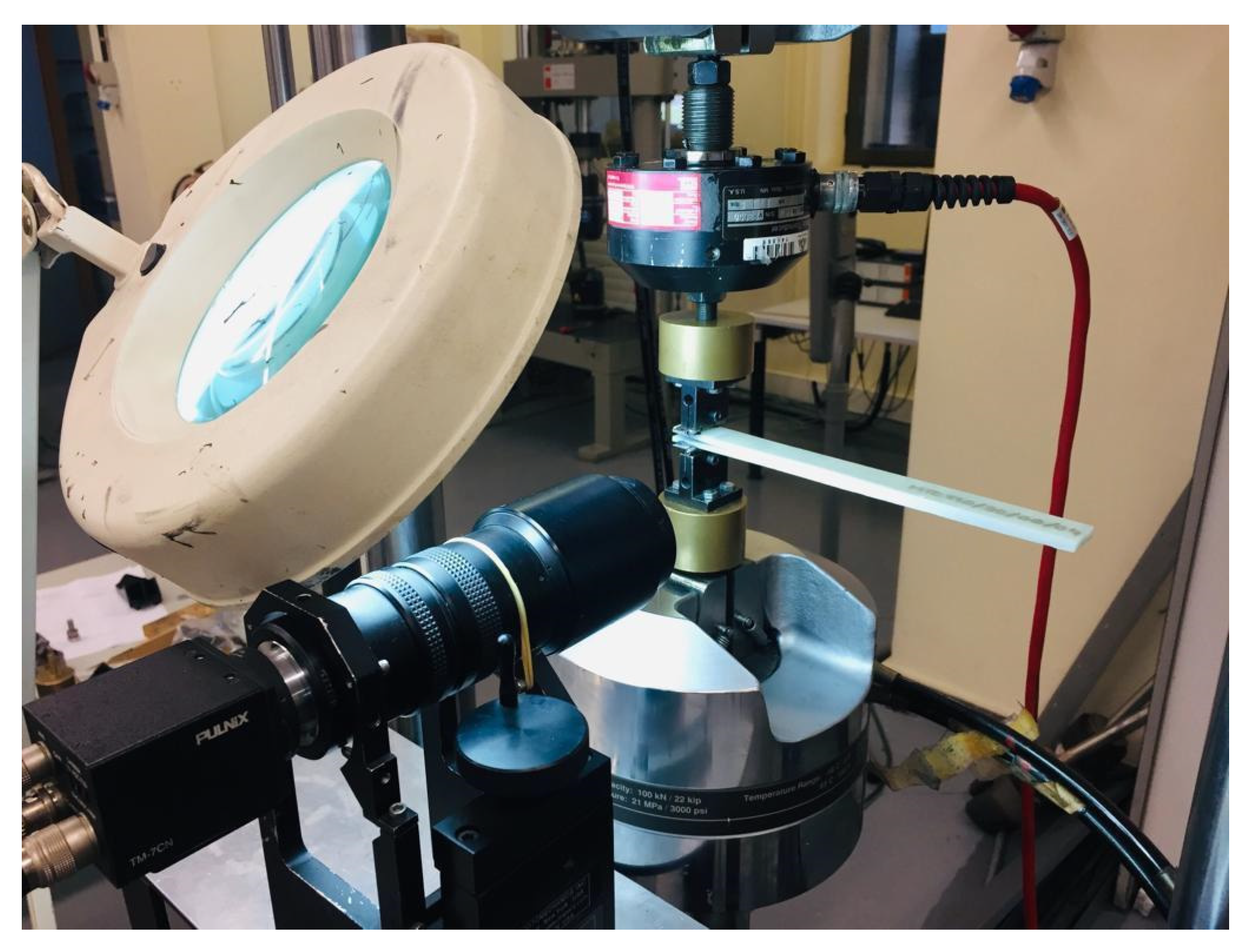

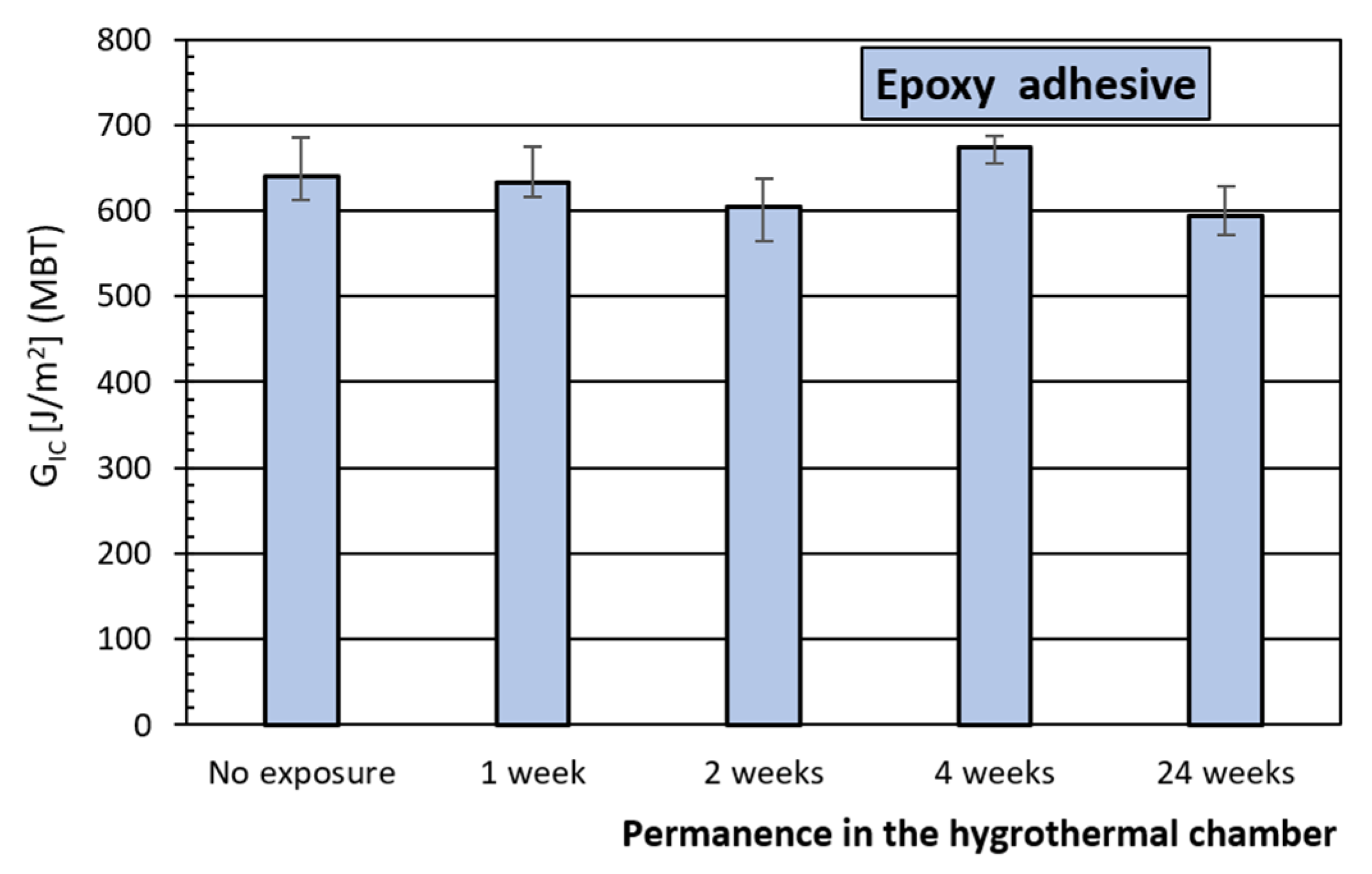
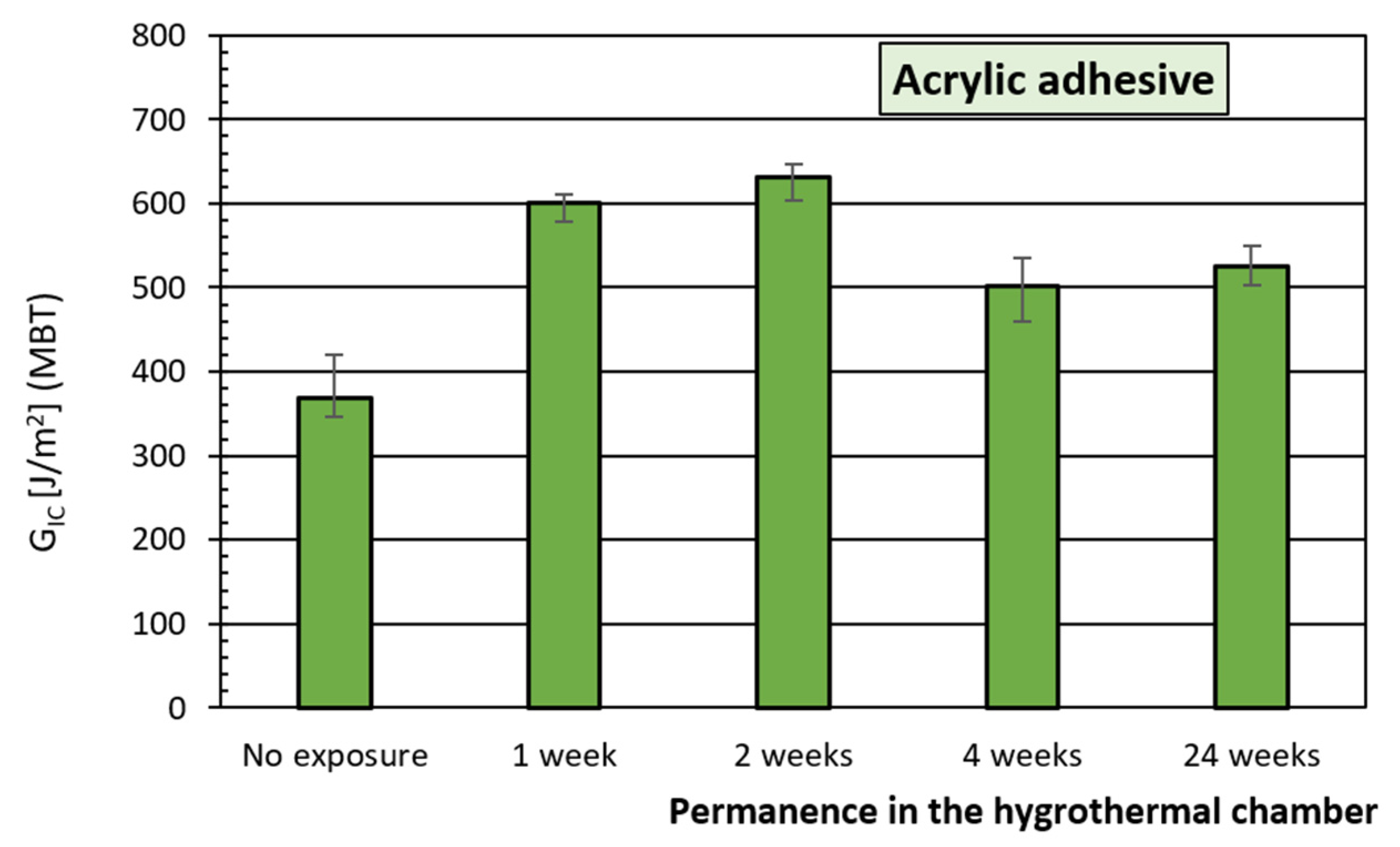
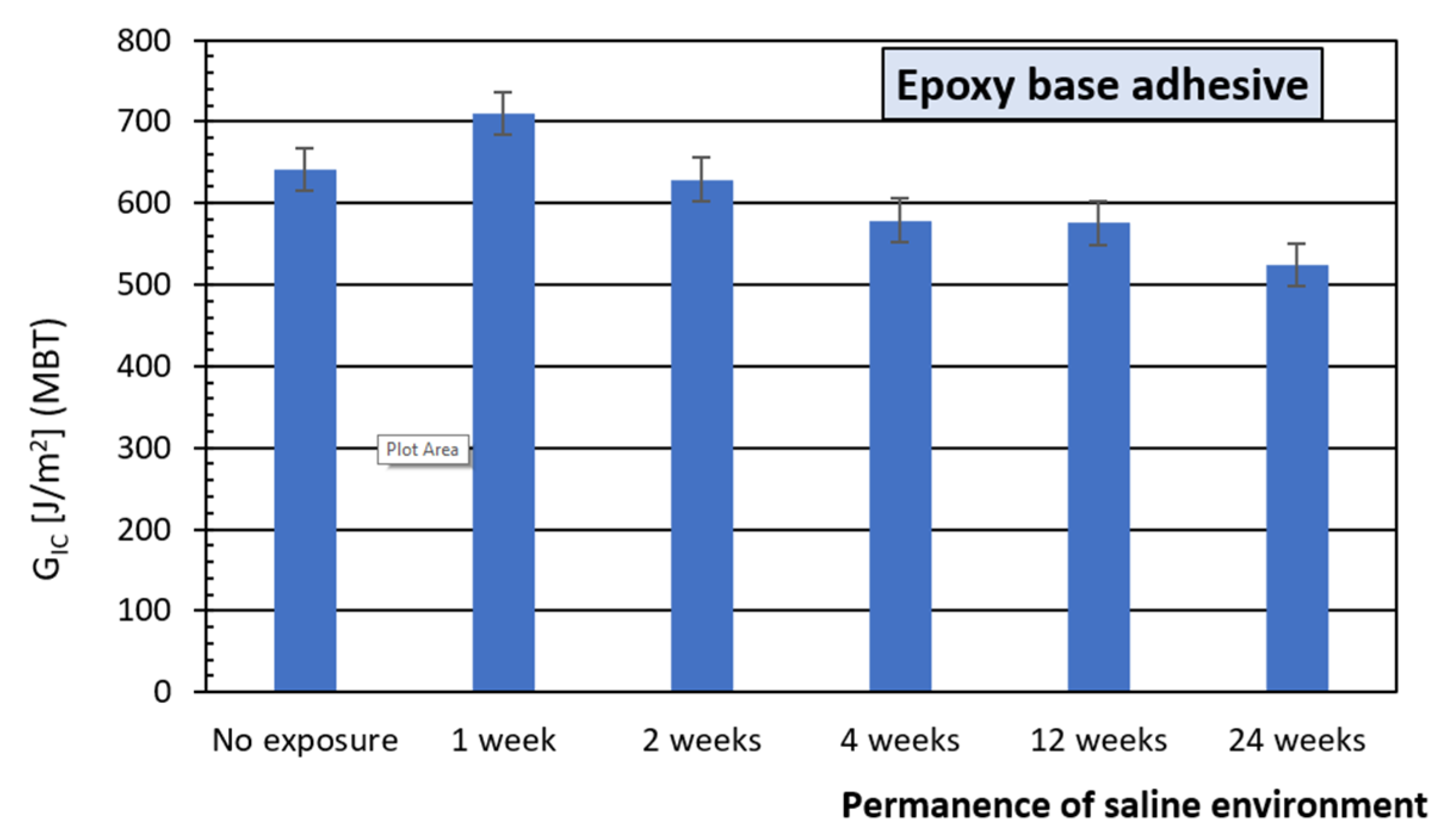
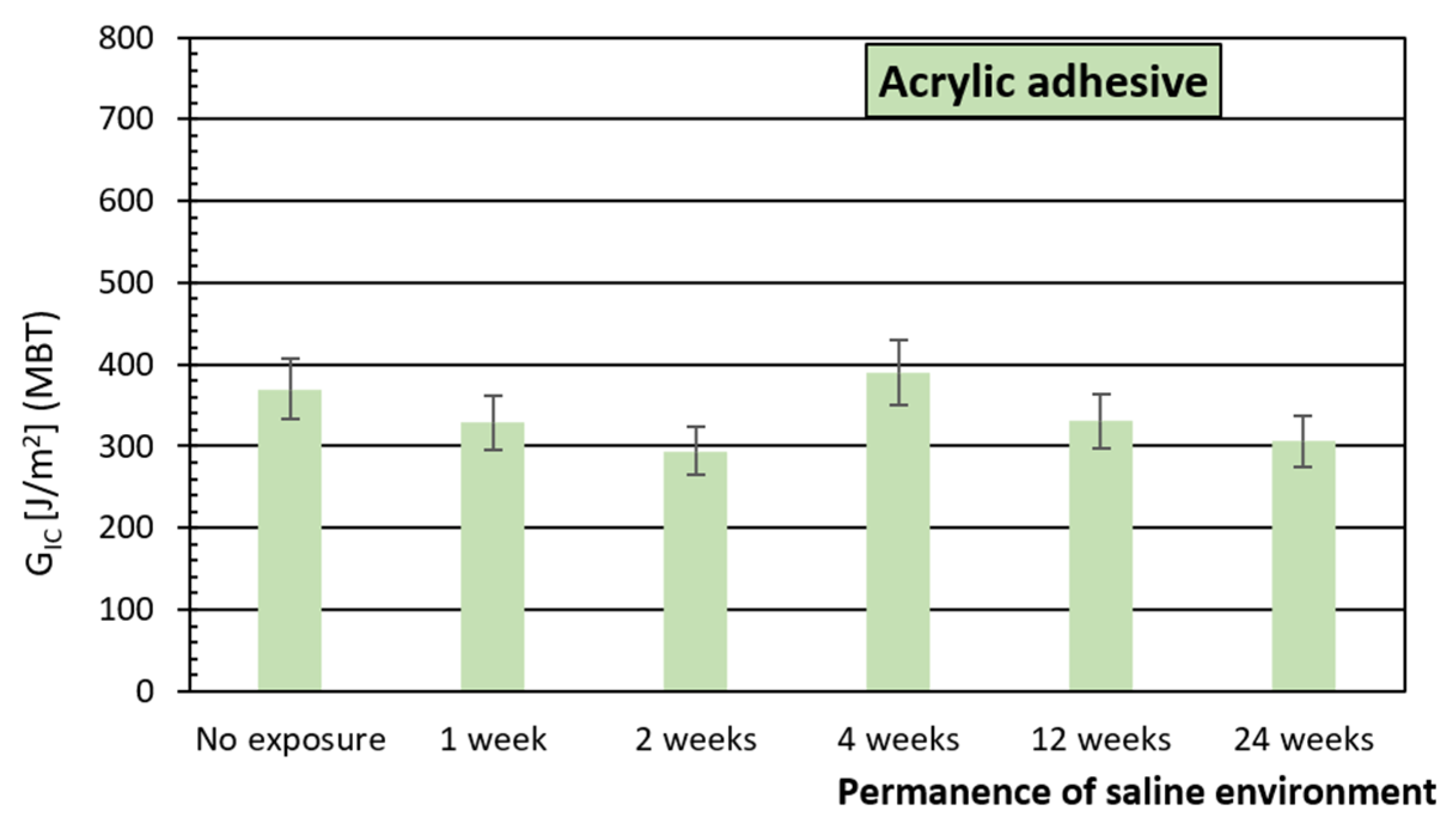


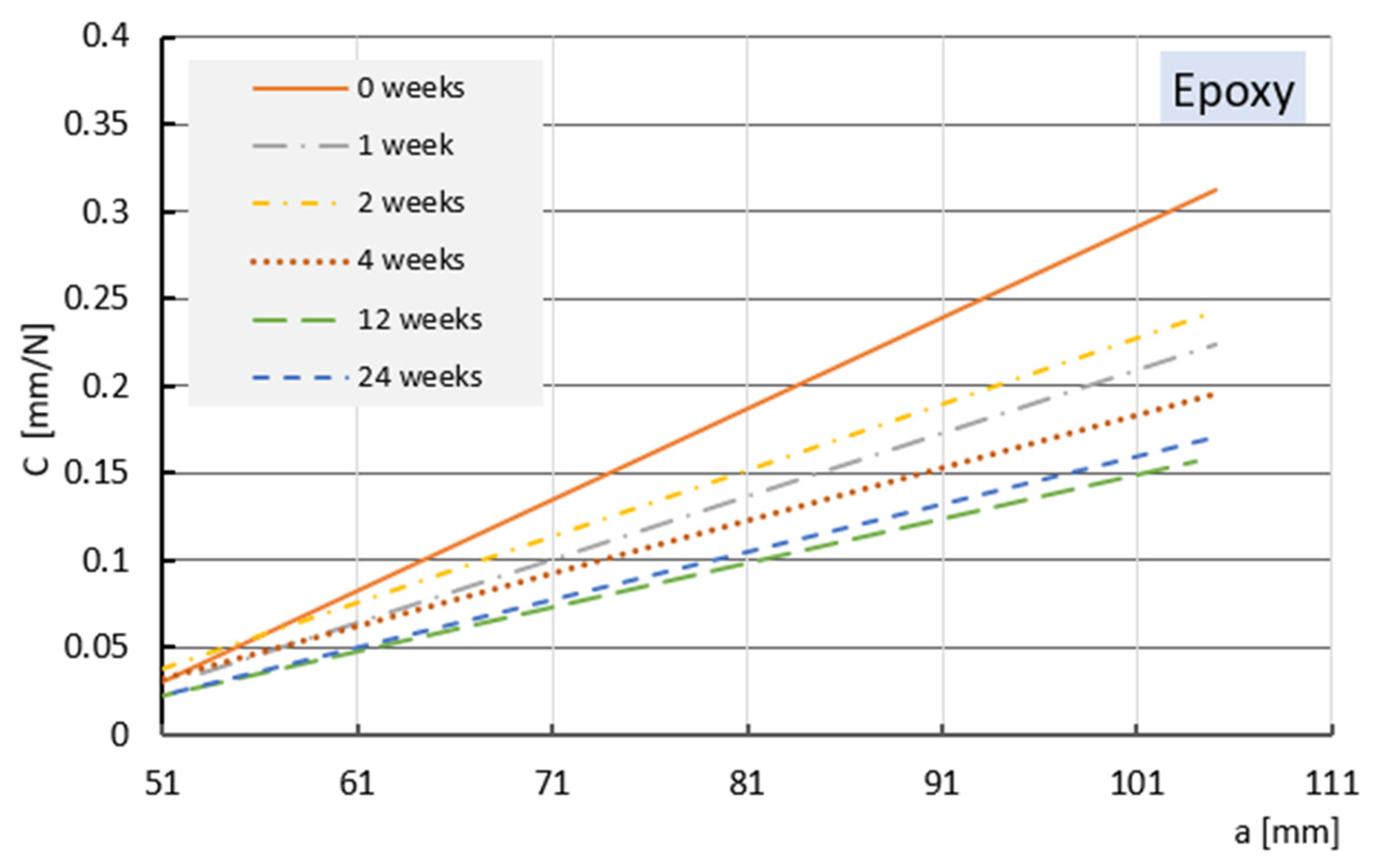
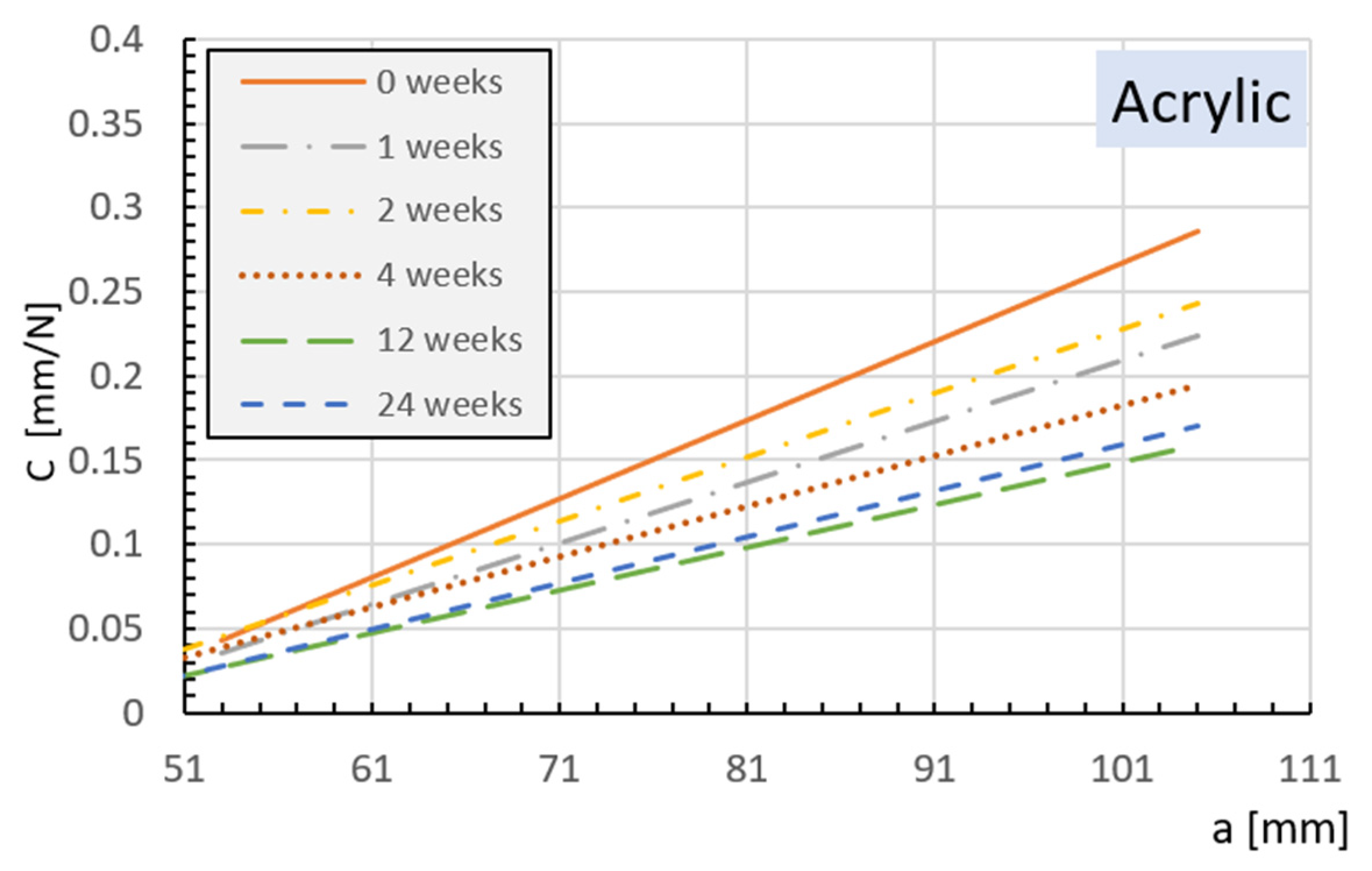
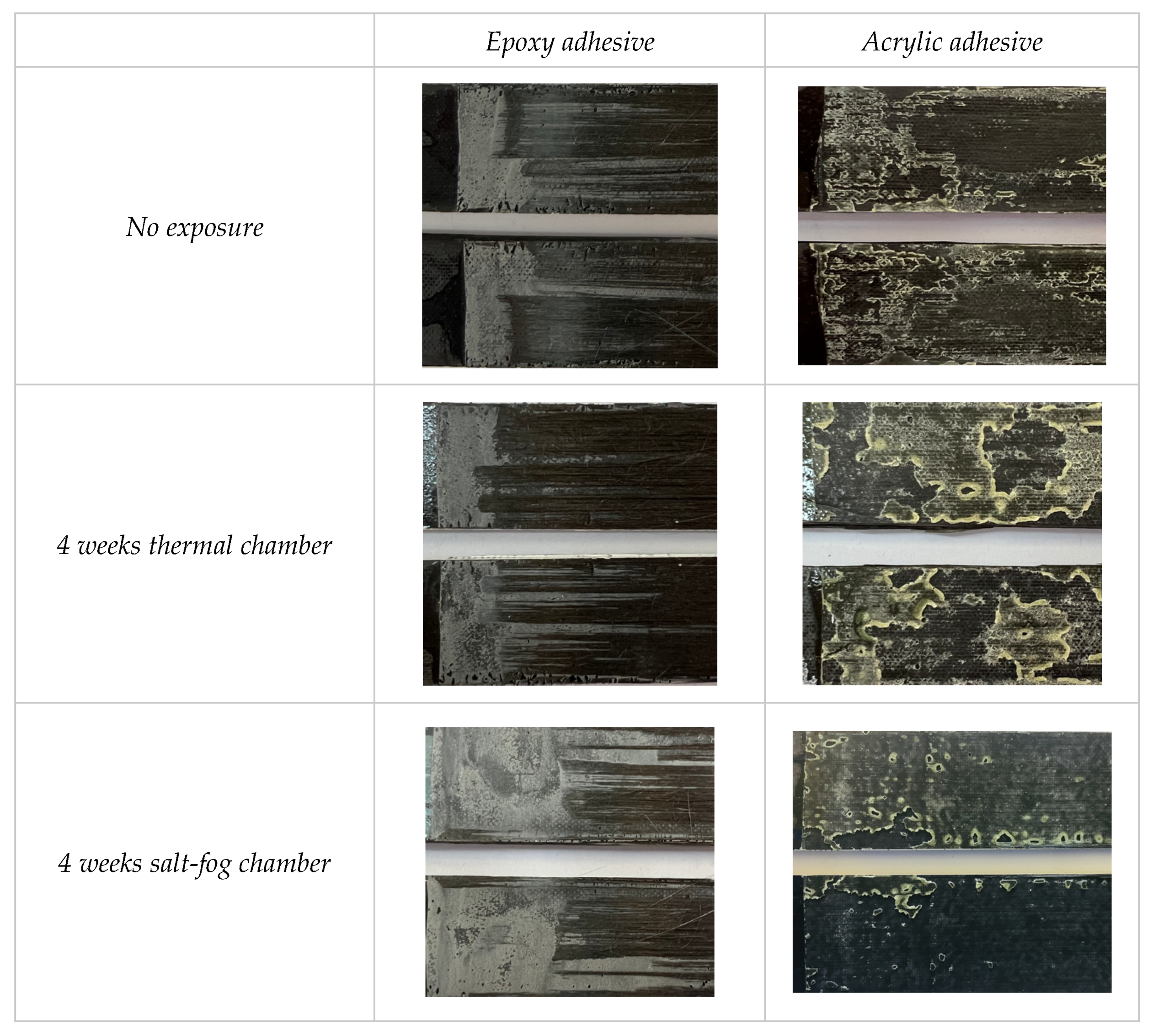
| Elastic Modulus a | Tensile Strength a | Shear Modulus b | Shear Strength b | |||
|---|---|---|---|---|---|---|
| Material | E11 (GPa) | E22 (Gpa) | σ11 (Mpa) | σ22 (Mpa) | G12 (Gpa) | τmax (Mpa) |
| MTC510-UD300-HS | 122 CV = 8.5% | 8.5 CV = 8% | 1156 CV = 12.5% | 28 CV = 11.8% | 5.2 CV = 9.8% | 37 CV = 2% |
| Base | Viscosity (mPa·s) | Elastic Modulus (GPa) | Tensile Strength (MPa) | Shear Strength (MPa) | |
|---|---|---|---|---|---|
| Loctite® EA 9461™ | epoxy | 85,980 | 2.757 | 30 | 13 |
| 3M™ DP8810NS | acrylic | 90,000 | 0.87 | 11.5 | 22.9 |
| 0° | 90° | |||||
|---|---|---|---|---|---|---|
| Substrate | Ra (µm) | Rz (µm) | Rmax (µm) | Ra (µm) | Rz (µm) | Rmax (µm) |
| Natural State | 2.279 | 10.0 | 11.43 | 1.866 | 8.96 | 10.38 |
| Sanding | 3.092 | 11.54 | 16.61 | 3.313 | 11.8 | 14.61 |
Publisher’s Note: MDPI stays neutral with regard to jurisdictional claims in published maps and institutional affiliations. |
© 2022 by the authors. Licensee MDPI, Basel, Switzerland. This article is an open access article distributed under the terms and conditions of the Creative Commons Attribution (CC BY) license (https://creativecommons.org/licenses/by/4.0/).
Share and Cite
Vigón, P.; Argüelles, A.; Mollón, V.; Lozano, M.; Bonhomme, J.; Viña, J. Study of the Influence of the Type of Aging on the Behavior of Delamination of Adhesive Joints in Carbon-Fiber-Reinforced Epoxy Composites. Materials 2022, 15, 3669. https://doi.org/10.3390/ma15103669
Vigón P, Argüelles A, Mollón V, Lozano M, Bonhomme J, Viña J. Study of the Influence of the Type of Aging on the Behavior of Delamination of Adhesive Joints in Carbon-Fiber-Reinforced Epoxy Composites. Materials. 2022; 15(10):3669. https://doi.org/10.3390/ma15103669
Chicago/Turabian StyleVigón, Paula, Antonio Argüelles, Victoria Mollón, Miguel Lozano, Jorge Bonhomme, and Jaime Viña. 2022. "Study of the Influence of the Type of Aging on the Behavior of Delamination of Adhesive Joints in Carbon-Fiber-Reinforced Epoxy Composites" Materials 15, no. 10: 3669. https://doi.org/10.3390/ma15103669






